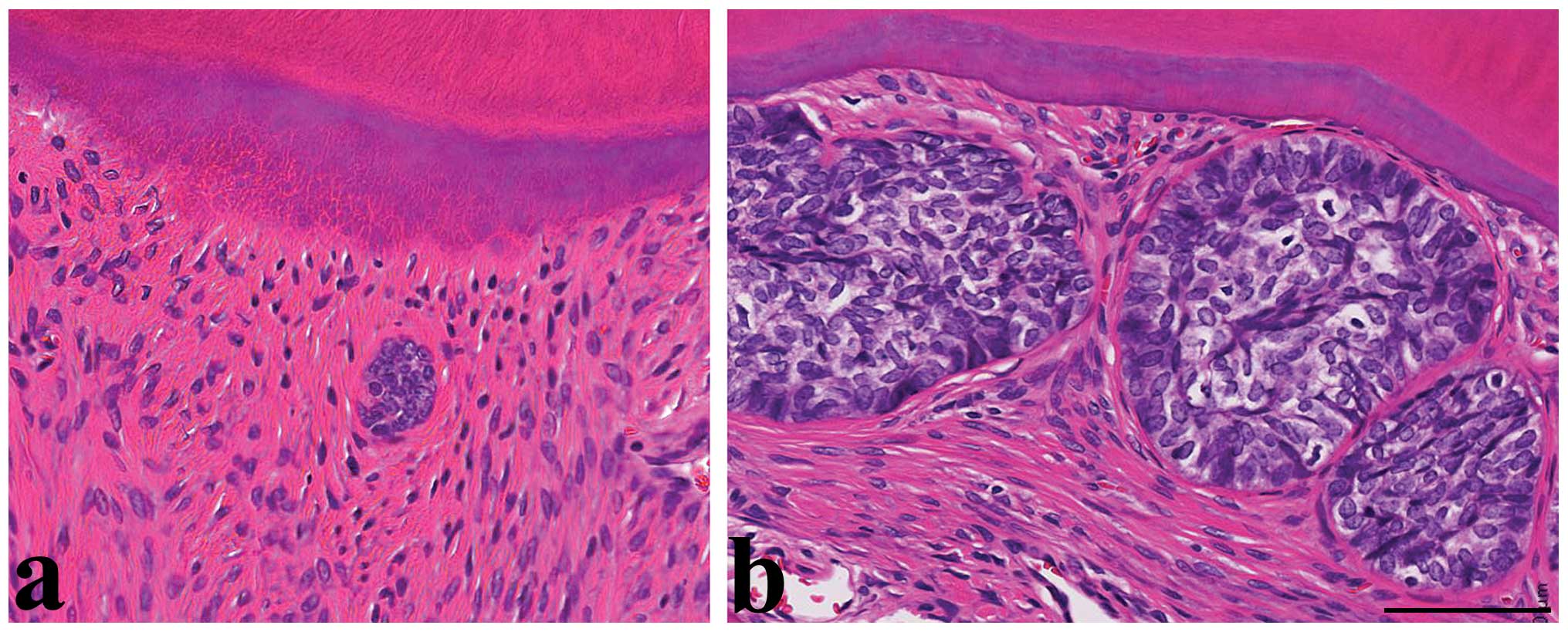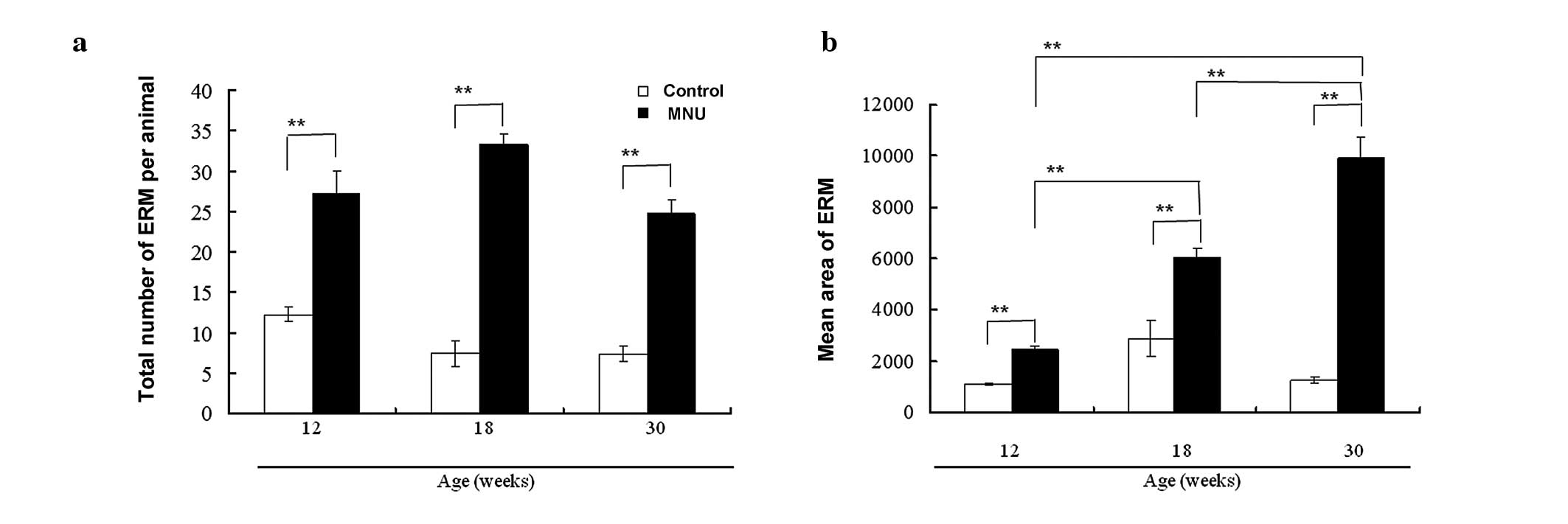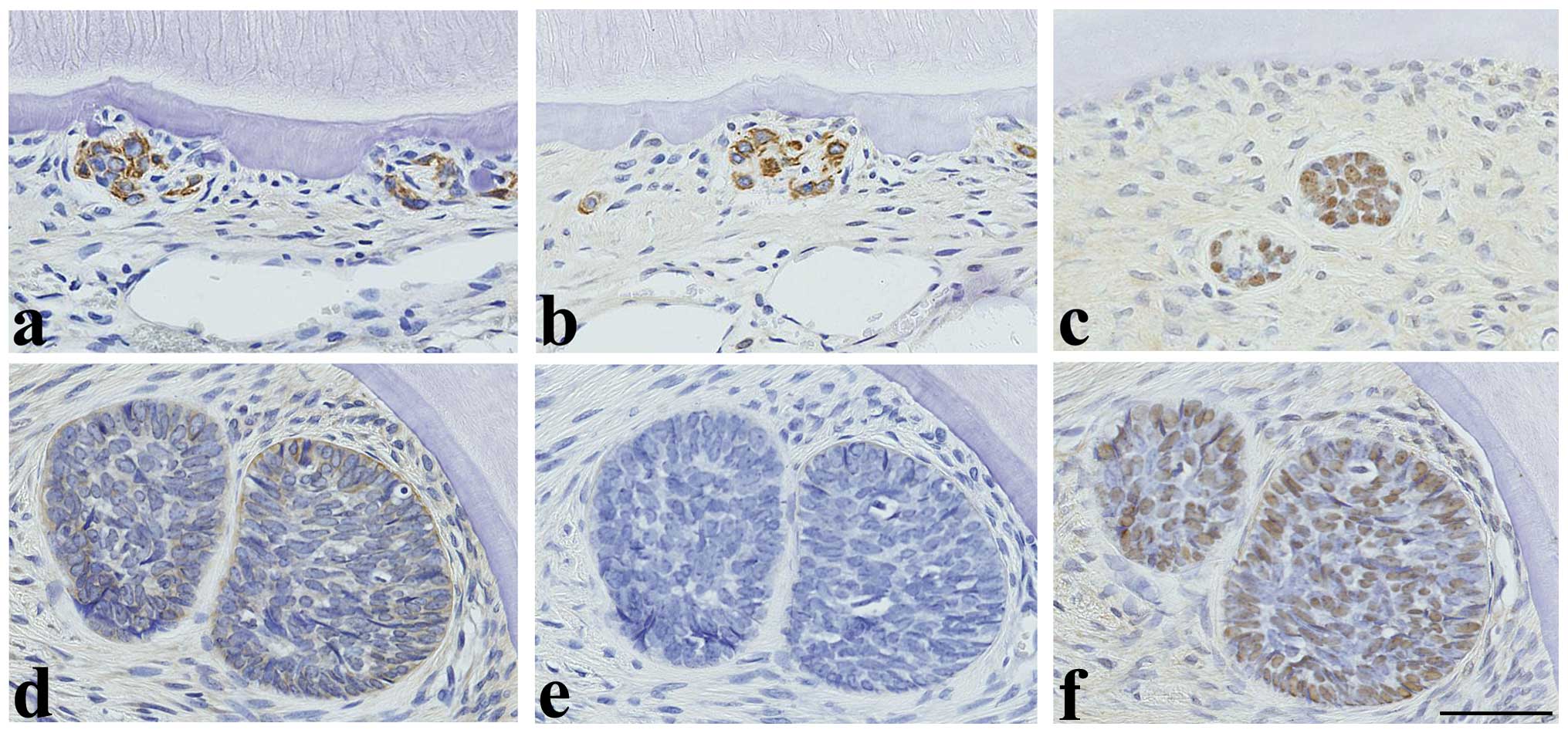|
1
|
Brown HR and Hardisty JF: Oral cavity,
esophagus, and stomach. Pathology of the Fischer Rat: Reference and
Atlas. Boorman GA, Montgomery CA Jr and MacKenzie WF: Academic
Press; San Diego: pp. 9–30. 1990
|
|
2
|
Long PH and Leininger JR: Teeth. Pathology
of the Mouse: Reference and Atlas. Maronpot RR, Boorman GA and Gaul
BW: Cache River Press; Vienna: pp. 13–28. 1999
|
|
3
|
Abe T and Miyajima H: Effect of drugs on
developing enamel in rat incisors. J Toxicol Pathol. 3:245–256.
1990.(Abstract in English, text in Japanese).
|
|
4
|
Kuijpers MH, van de Kooij AJ and Slootweg
PJ: The rat incisor in toxicologic pathology. Toxicol Pathol.
24:346–360. 1996. View Article : Google Scholar : PubMed/NCBI
|
|
5
|
Weber K: Induced and spontaneous lesions
in teeth of laboratory animals. J Toxicol Pathol. 20:203–213. 2007.
View Article : Google Scholar
|
|
6
|
Kumamoto H: Molecular pathology of
odontogenic tumors. J Oral Pathol Med. 35:65–74. 2006. View Article : Google Scholar : PubMed/NCBI
|
|
7
|
Takeda Y: Histogenesis and clinical
pathology of odontogenic tumors. Dent J Iwate Med Univ. 31:143–152.
2006.(In Japanese).
|
|
8
|
Edwards MB: Some effects of
N-methylnitrosourea on the oral and odontogenic tissues of the
Syrian golden hamster. Arch Oral Biol. 23:515–524. 1978. View Article : Google Scholar : PubMed/NCBI
|
|
9
|
Maeda H, Kameyama Y, Fujita K, Sato E and
Mizutani M: Experimental odontogenic tumors produced by
ethylnitrosourea injections and mechanical injuries. J Oral Pathol
Med. 20:296–299. 1991. View Article : Google Scholar : PubMed/NCBI
|
|
10
|
Satoh H, Usegi Y, Kawabata T, Mori K,
Fujii F and Kashimoto Y: Morphological classification of dental
lesions induced by various antitumor drugs in mice. Toxicol Pathol.
29:292–299. 2001. View Article : Google Scholar : PubMed/NCBI
|
|
11
|
Azuma T and Komori A: An experimental
study of odontogenic tumors in rats. Induction of tumors by gastric
intubation of MNU. Jpn J Oral Biol. 27:631–639. 1985. View Article : Google Scholar
|
|
12
|
Berman JJ and Rice JM: Odontogenic tumours
produced in Fischer rats by a single intraportal injection of
methylnitrosourea. Arch Oral Biol. 25:213–220. 1980. View Article : Google Scholar : PubMed/NCBI
|
|
13
|
Eblin H, Barbachan JJD, Do Valle JGC and
De Oliveira LY: N-Methyl-N-nitrosourea-induced odontogenic
neoplasms in rats. J Dent Res. 52:1771973. View Article : Google Scholar : PubMed/NCBI
|
|
14
|
Eisenberg E, Murthy AS, Vawter GF and
Krutchkoff DJ: Odontogenic neoplasms in Wistar rats treated with
N-methylnitrosourea. Oral Surg Oral Med Oral Pathol. 55:481–486.
1983. View Article : Google Scholar : PubMed/NCBI
|
|
15
|
Gardner DG: Experimentally induced
ameloblastomas: a critical review. J Oral Pathol Med. 21:337–339.
1992. View Article : Google Scholar : PubMed/NCBI
|
|
16
|
Leaver DD, Swann PF and Magee PN: The
induction of tumors in the rat by a single oral dose of
N-nitrosomethylurea. Br J Cancer. 223:177–187. 1969. View Article : Google Scholar
|
|
17
|
Smulow J B, Konstantinidis A and
Sonnenschein C: Age-dependent odontogenic lesions in rats after a
single i.p. injection of N-nitroso-N-methylurea. Carcinogenesis.
4:1085–1088. 1983.PubMed/NCBI
|
|
18
|
Herrold KM: Odontogenic tumors and
epidermoid carcinomas of the oral cavity. An experimental study in
Syrian hamsters. Oral Surg Oral Med Oral Pathol. 25:262–272. 1968.
View Article : Google Scholar : PubMed/NCBI
|
|
19
|
Kohgo T: An experimental study of
odontogenic tumors in hamsters by N-nitrosomethylurea. J Stomatol
Soc Jpn. 39:191–212. 1972. View Article : Google Scholar : PubMed/NCBI
|
|
20
|
Kohgo T, Iizuka T and Shindoh M:
Pathological evaluation of the effects of intentional disocclusion
and overloading occlusion in odontogenesis disorders in
N-methylnitrosourea-treated hamsters. Toxicol Pathol. 27:226–232.
1999. View Article : Google Scholar : PubMed/NCBI
|
|
21
|
Wentz FM, Weinmann JP and Schour I: The
prevalence, distribution, and morphologic changes of the epithelial
remnants in the molar region of the rat. J Dent Res. 29:637–646.
1950. View Article : Google Scholar : PubMed/NCBI
|
|
22
|
Bykov VL: Epithelial cell rests of
Malassez: tissue, cell, and molecular biology. Morfologiia.
124:95–103. 2003.(In Russian).
|
|
23
|
Kat PS, Sampson WJ, Wilson DF and Wiebkin
OW: Distribution of the epithelial rests of Malassez and their
relationship to blood vessels of the periodontal ligament during
rat tooth development. Aust Orthod J. 19:77–86. 2003.PubMed/NCBI
|
|
24
|
Huang X, Bringas P, Slavkin HC and Chai Y:
Fate of HERS during tooth root development. Dev Biol. 334:22–30.
2009. View Article : Google Scholar : PubMed/NCBI
|
|
25
|
Shinmura Y, Tsuchiya S, Hata K and Honda
MJ: Quiescent epithelial cell rests of Malassez can differentiate
into ameloblast-like cells. J Cell Physiol. 217:728–738. 2008.
View Article : Google Scholar : PubMed/NCBI
|
|
26
|
Hamamoto Y, Hamamoto N, Nakajima T and
Ozawa H: Morphological changes of epithelial rests of Malassez in
rat molars induced by local administration of N-methylnitrosourea.
Arch Oral Biol. 43:899–906. 1998. View Article : Google Scholar : PubMed/NCBI
|
|
27
|
Rincon JC, Young WG and Bartold PM: The
epithelial cell rests of Malassez - a role in periodontal
regeneration? J Periodontal Res. 41:245–252. 2006. View Article : Google Scholar : PubMed/NCBI
|
|
28
|
Yagoto M, Shimojyo Y, Uotani Y, et al:
Methodology of histological preparation of rat teeth tissue
including incisor and molar. Jpn J Histotech. 9:29–32. 2000.(In
Japanese).
|
|
29
|
Long PH, Leininger JR and Lieuallen WG:
Non-proliferative lesions of bone, cartilage, tooth, and synovium
in rats. Guides for Toxicologic Pathology STP/ARP/AFIP Washington,
D.C.: 1996
|
|
30
|
Long PH, Leininger JR, Nold JB and
Lieuallen WG: Proliferative lesions of bone, cartilage, tooth, and
synovium in rats. Guides for Toxicologic Pathology STP/ARP/AFIP
Washington, D.C.: 1996
|
|
31
|
Kurihara H, Shinohara H, Yoshino H, Takeda
K and Shiba H: Neurotrophins in cultured cells from periodontal
tissues. J Periodontol. 74:76–84. 2003. View Article : Google Scholar : PubMed/NCBI
|
|
32
|
Woodnutt DA and Byers MR: Morphological
variation in the tyrosine receptor kinase A- immunoreactive
periodontal ligament. Arch Oral Biol. 46:163–171. 2001. View Article : Google Scholar : PubMed/NCBI
|
|
33
|
Brikic A, Mutlu S, Kocak-Berberoglu H and
Olgac V: Pathological changes and immunoexpression of p63 gene in
dental follicles of asymptomatic impacted lower third molars: an
immunohistochemical study. J Craniofac Surg. 21:854–857. 2010.
View Article : Google Scholar : PubMed/NCBI
|
|
34
|
Casasco M, Cornaglia AI, Riva F, Calligaro
A and Casasco A: Expression of p63 transcription factor in
ectoderm-derived oral tissues. Int J Anat Embryol. 111:125–131.
2006.PubMed/NCBI
|
|
35
|
Kock M, Nolting D, Kjaer KW, Hansen BF and
Kjaer I: Immunohistochemical expression of p63 in human prenatal
tooth primordia. Acta Odontol Scand. 63:253–257. 2005. View Article : Google Scholar : PubMed/NCBI
|
|
36
|
Nam H, Kim J, Park J, et al: Expression
profile of the stem cell markers in human Hertwig’s epithelial root
sheath/epithelial rests of Malassez cells. Mol Cells. 31:355–360.
2011.PubMed/NCBI
|
|
37
|
Rufini A, Weil M, McKeon F, Barlattani A,
Melino G and Candi E: p63 protein is essential for the embryonic
development of vibrissae and teeth. Biochem Biophys Res Commun.
340:737–741. 2006. View Article : Google Scholar : PubMed/NCBI
|
|
38
|
Xiong J, Gronthos S, Krzysztof M and
Bartold PM: Characterisation and stem-cell properties of epithelial
cell rests of Malassez. In: Abstract in IADR/AADR/CADR 89th General
Session and Exhibition; San Diego, USA. 2011
|
|
39
|
Uchida T, Tanabe T and Fukae M:
Immunocytochemical localization of amelogenins in the deciduous
tooth germs of the human fetus. Arch Histol Cytol. 52:543–552.
1989. View Article : Google Scholar : PubMed/NCBI
|
|
40
|
Uchida T, Tanabe T, Fukae M, et al:
Immunochemical and immunohistochemical studies, using antisera
against porcine 25 kDa amelogenin, 89 kDa enamelin and the 13–17
kDa nonamelogenins, on immature enamel of the pig and rat.
Histochemistry. 96:129–138. 1991.PubMed/NCBI
|
|
41
|
Hasegawa N, Kawaguchi H, Ogawa T, Uchida T
and Kurihara H: Immunohistochemical characteristics of epithelial
cell rests of Malassez during cementum repair. J Periodont Res.
38:51–56. 2003. View Article : Google Scholar : PubMed/NCBI
|
|
42
|
Nishio C, Wazen R, Kuroda S, Moffatt P and
Nanci A: Disruption of periodontal integrity induces expression of
apin by epithelial cell rests of Malassez. J Periodont Res.
45:709–713. 2010. View Article : Google Scholar : PubMed/NCBI
|
|
43
|
Lewis DJ, Cherry CP and Gibson WA:
Ameloblastoma (adamantinoma) of the mandible in the rat. J Comp
Pathol. 90:379–384. 1980. View Article : Google Scholar : PubMed/NCBI
|
|
44
|
Wright JT, Hansen L, Mahler J, Szczesniak
C and Spalding JW: Odontogenic tumors in the v-Ha-ras (TGAC)
transgenic mouse. Archs Oral Biol. 40:631–638. 1995. View Article : Google Scholar : PubMed/NCBI
|
|
45
|
Grachtchouk M, Liu J, Wang A, et al:
Odontogenic keratocysts arise from quiescent epithelial rests and
are associated with deregulated hedgehog signaling in mice and
humans. Am J Pathol. 169:806–814. 2006. View Article : Google Scholar : PubMed/NCBI
|
|
46
|
Gao Y, Yang G, Weng T, et al: Disruption
of Smad4 in odontoblasts causes multiple keratocytic odontogenic
tumors and tooth malformation in mice. Mol Cell Biol. 29:5941–5951.
2009. View Article : Google Scholar : PubMed/NCBI
|
|
47
|
Yamashiro T, Fujiyama K, Fukunaga T, Wang
Y and Takano-Yamamoto T: Epithelial rests of Malassez express
immunoreactivity of TrkA and its distribution is regulated by
sensory nerve innervation. J Histochem Cytochem. 48:979–984. 2000.
View Article : Google Scholar : PubMed/NCBI
|
|
48
|
Lo Muzio L, Santarelli A, Caltabiano R, et
al: p63 expression correlates with pathological features and
biological behaviour of odontogenic tumours. Histopathology.
49:211–214. 2006.PubMed/NCBI
|
|
49
|
Hamamoto Y, Nakajima T, Ozawa H and Uchida
T: Production of amelogenin by enamel epithelium of Hertwig’s root
sheath. Oral Surg Oral Med Oral Pathol Oral Radiol Endod.
81:703–709. 1996.PubMed/NCBI
|
|
50
|
Kumamoto H, Yoshida M and Ooya K:
Immunohistochemical detection of amelogenin and cytokeratin 19 in
epithelial odontogenic tumors. Oral Dis. 7:171–176. 2001.
View Article : Google Scholar : PubMed/NCBI
|
|
51
|
Ravindranath RM, Tam WY, Bringas P Jr,
Santos V and Fincham AG: Amelogenin-cytokeratin 14 interaction in
ameloblasts during enamel formation. J Biol Chem. 276:36586–36597.
2001. View Article : Google Scholar : PubMed/NCBI
|
|
52
|
Crivelini MM, de Araújo VC, de Sousa SO
and de Araújo NS: Cytokeratins in epithelia of odontogenic
neoplasms. Oral Dis. 9:1–6. 2003. View Article : Google Scholar : PubMed/NCBI
|
|
53
|
Rufini A, Barlattani A, Docimo R, et al:
p63 in tooth development. Biochem Pharmacol. 82:1256–1261. 2011.
View Article : Google Scholar
|
|
54
|
Kumamoto H, Ohki K and Ooya K: Expression
of p63 and p73 in ameloblastomas. J Oral Pathol Med. 34:220–226.
2005. View Article : Google Scholar : PubMed/NCBI
|



















